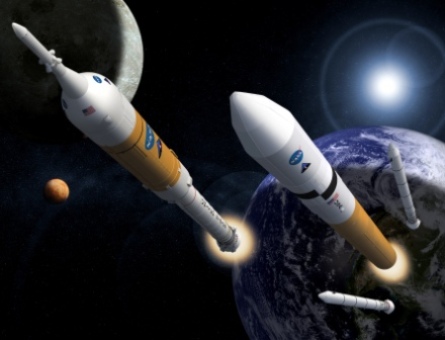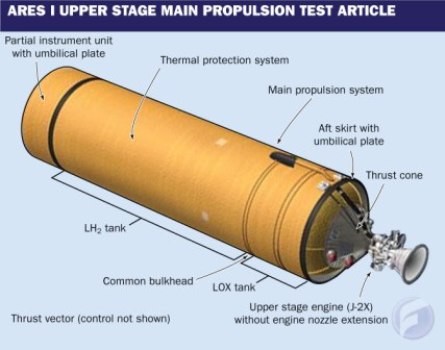For NASA's Constellation programme, using 25-year-old Space Shuttle flight-proven systems seemed like a good idea for the agency's new Moon rockets.
Since their proposal in 2005, however, the launchers' development progress has seen Shuttle-derived design options dropped while others have caused additional problems.
|
|---|
Above: NASA's Ares rockets with the Earth, Moon and Mars in the background |
The first test for the Ares V cargo launch vehicle (CaLV), CLV's heavier, Altair lunar lander and Earth departure stage launching sibling, is expected in 2018.
Beyond the much publicised CLV solid-rocket motor oscillation problem, other issues for Ares I include pocket buckling in its upper-stage liquid hydrogen (LH2) tank, an immature first-stage forward skirt avionics box design, protection for parachutes against the interstage's shaped linear charge separation system and first-stage thrust vector control (TVC) changes.
These outstanding issues did not stop NASA from declaring preliminary design review completion for the Ares I first-stage in June, while the upper stage review was to conclude this week.
NASA likes to promote the progress of Ares I upper-stage and instrument-unit mock-ups, manufacturing technology testing, launch abort system motor firings, parachute drops, 6,000h of CLV windtunnel tests, first-stage development motor fabrication and facility upgrades for future integrated vehicle ground vibration testing.
The CLV vehicle stack preliminary design review started in July, with completion planned for September, but the agency also expects to have what it calls a first-stage "delta PDR" to address the oscillation solution and its impact on the vehicle.
Speaking at the 44th American Institute of Aeronautics and Astronautics' Joint Propulsion Conference in Hartford, Connecticut, NASA's Ares project office deputy manager Teresa Vanhooser explained that oscillation was identified as a potential problem by the Shuttle programme and has since been seen in simulations and windtunnel testing.
All solid rockets suffer from this "organ pipe" acoustic resonance as pressure waves travel up and down the length of the motor.
In April NASA made public possible solutions to the problem that included first-stage "tuned" mass dampers. To reduce stress around the joints of the motor's five segments, NASA has chamfered the centre segment's solid fuel corners.
|
|---|
Above: changes to NASA's Ares I crew launch vehicle's solid motor first-stage |
The most visible use of Shuttle systems, the solid rocket boosters (SRB), were originally to be used as is, with four segments, for both the CLV's first stage and as "strap-on" motors for the CaLV.
Changed to five segments for Ares I, and to 5.5 to allow the CaLV's core stage to be lengthened, the CLV's first-stage forward skirt has undergone changes and it will get a nozzle extension for the first lunar mission.
The CLV and CaLV versions are to get widened throats, lowered burn rates with a modified polybutadiene acrylonitrile (PBAN) fuel and the insulation and liners altered to remove toxic materials.
On 5 August NASA also asked for electric TVC proposals to replace the Shuttle legacy SRB TVC hydraulic power units.
Only the original SRB igniter is likely to be untouched as steel casings may be replaced by filament wound casings for the Ares V to lift an extra 3,000kg (6,600lb) of payload beyond its margin of 6,000kg to trans-lunar injection (TLI).
Filament wound casings can cope with the hydroxy-terminated polybutadiene (HTPB) fuel's higher thrust levels that would deliver the 9,000kg margin. So the original Shuttle SRB's PBAN fuel would be changed for the more potent HTPB.
NASA has always asserted that the CLV first stage and CaLV SRBs would be recoverable for reuse. But a 2007 reusability study's conclusions, presented by NASA Marshall Spaceflight Center's Andrew Schorr at the joint propulsion conference, stated: "If performance remains an issue for Ares I and V then expendability provides measurable performance benefits." Removing recovery subsystems generated up to 2,500kg payload increase for Ares I and up to 4,400kg for Ares V, but expendable boosters had increased inspection and static tests costs.
Another Shuttle-related choice was the use of the Space Shuttle Main Engine (SSME) for the CaLV five core-stage engines, its Earth departure stage (EDS) and the Ares I upper stage.
That choice was dropped for the CLV upper stage because the SSME was designed to start at sea level and not 194,000ft (59,000m), at which the upper stage operates.
And the costs of manufacturing the reusable SSME were deemed too expensive with cheaper expendable alternatives such as the more powerful Pratt & Whitney Rocketdyne RS-68 and a new version of the Apollo-era Saturn V upper stage J-2, the J-2X.
NASA did consider two versions of the new P&W Rocketdyne J-2X, with 274,000lb (1,220kN) and 294,000lb thrust each, but opted for the more powerful version and cut the number of J-2Xs on the EDS from two to one.
Although the J-2X was identified in 2006 as the Ares' development bottleneck, it is ahead of other CLV elements and will start its two-month critical design review on 8 September.
The J-2X uses technology from the 1970s' J-2S version, the P&W Rocketdyne RS-27 and RS-68 engines and the 1990s' X-33 vehicle's XRS-2200's turbomachinery.
Testing has included six powerpack "hot-fire" tests with over 1,300s of operating time and equivalent thrust levels of 274,000lb. A composite nozzle was considered with French firm Snecma Propulsion Solide's help, but now an all-new metal nozzle design will be used.
Six RS-68Bs will power the Ares V core stage instead of five. The US Air Force is helping develop it as it uses the 68A version for the United Launch Alliance Delta IV.
The 68B changes include a modified main injector to improve specific impulse and thrust and an ablative nozzle to cope with the Ares V's much longer burn time.
NASA also wants to avoid the ignited hydrogen plume that expands up the Delta IV's sides during engine ignition. To do this the RS-68B will use less helium and less LH2 by improving its powerpack's turbine seals and modifying the ignition start sequence.
Integrating six engines into the core stage, widened from 8.4m (27.5ft) to 10m, will also be a challenge. NASA's exploration launch project office's advanced planning manager John "Phil" Sumrall identified five RS-68 turbopump exhaust ducts' integration as a problem in his May 2007 paper and six will make it more complicated. The core stage's huge consumable needs also present infrastructure issues.
United Launch Alliance chief executive Michael Gass told Flight at the Hartford conference that with only four Ares V launches a year the infrastructure to generate the helium, liquid oxygen (LOX) and LH2 required will be expensive.
For the Ares I upper stage and Ares V core and Earth departure stages, clean-sheet designs will be used, although their manufacture will employ Space Shuttle external tank-originated production technology at NASA's Michoud Assembly Facility (MAF) near New Orleans.
Designed by NASA, but manufactured by Boeing at MAF, the Ares I upper stage is soon to start its design analysis cycle (DAC)-3.
At its DAC-2B the stage's mass allocation was increased and in Hartford upper-stage deputy element manager Craig McArthur said the "stage is under its mass allocation", with its 156,000kg dry mass.
To achieve this NASA had conducted a study of the Apollo programme's Saturn IVB in 2006. Used for mass allocation guidance Apollo "grey beards" were helping up to July last year.
To further improve mass allocation the LOX tank baffles, composite interstage stiffness, the hydrogen barrel sections and other elements were all re-examined by April this year.
While this work continued, one change that was made public was a LOX, LH2 tank common bulkhead. All this work will culminate in the stage's main propulsion test article being tested in 2011.
|
|---|
Above: The Ares I crew launch vehicle upper stage main propulsion test article will not be an exact replica of the flight model |
Vanhooser does not deny the increased stiffness, saying "a number of different concepts" are being evaluated.
Vanhooser says detailed Ares V work is not expected to start until 2011. NASA's 9 July Ares V request for information has a timetable showing the first DAC starting next year and preliminary and critical design reviews in 2012 and 2013.
To date EDS designs have centred on its low-Earth orbit loiter time before TLI, with changes from solar arrays for a 90-day loiter to fuel cells for four days.
The EDS has widened from 8.4m to 10m to match the core stage and the fairing is expected to change to a bullet-like "Ogive" shape.
For the CLV first stage and CaLV SRBs, avionics is expected to be the most expensive item after segment casings. The Ares I's avionics are in the first stage's forward skirt and at the top of the upper stage, in its instrument unit, and in that stage's aft skirt and interstage - that connects it to the first stage.
But the Ares I forward skirt avionics mass is unknown, according to Marshall Spaceflight Center's Angie Jackman, while CLV upper-stage avionics team member Charles Nola says the design approach of single-fault tolerance had reduced complexity and saved mass and that lithium ion batteries would probably be used for the same reason.
This focus on mass is reflected in NASA's own internal Constellation documentation that paints a picture of vehicle designs where the issue is so critical that changes to cope with problems, such as oscillation, are inherently weight sensitive.
They are so sensitive that even avionics' mass excesses are described as having "mission performance impacts".
New launchers customarily have development issues. One rocket veteran, for example, told Flight: "On Apollo there were so many unknowns we gave ourselves plenty of [design and performance] margins. They [Constellation programme] thought they knew a lot more...[because of Shuttle]. They haven't given themselves enough margin."
Source: Flight International





























